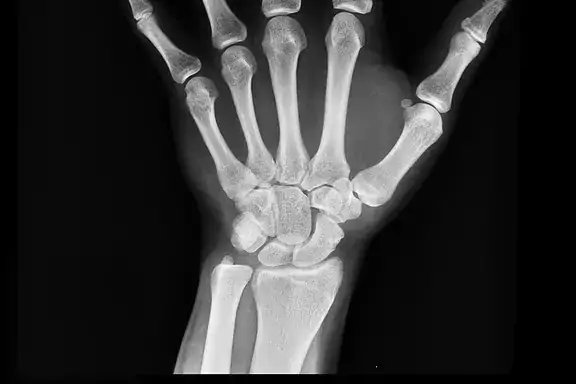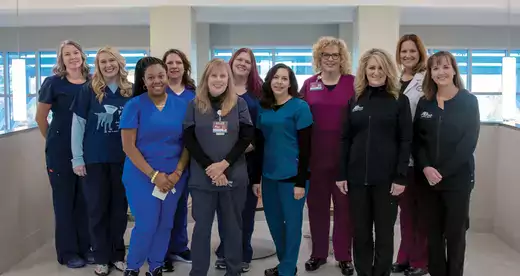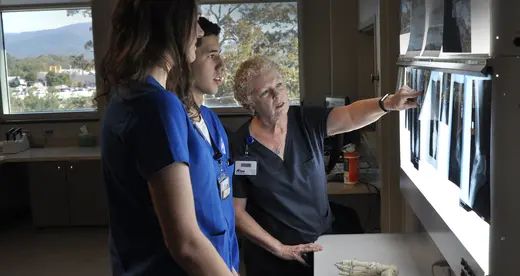The mission of the Asheville-Buncombe Technical Community College (A-B Tech) Radiography Program is to prepare competent entry-level radiographers in the cognitive (knowledge), psychomotor (skills), and affective (behavior) learning domains for the health care industry located in Western North Carolina.
Programs
| Title | Credential | Credit Hours | Link to program details |
|---|---|---|---|
| Radiography A.A.S. | Degree | 72 | |
Good to Know
- Radiography Admission Requirements
- Radiography Pre-Admission Information
- Radiography Technical Standards
If you do not complete the requirements explained in the Information Session 2024 PowerPoint, you will not be able to apply for the 2024 fall cohort.
The mission of the Asheville-Buncombe Technical Community College (A-B Tech) Radiography Program is to prepare competent entry-level radiographers in the cognitive (knowledge), psychomotor (skills), and affective (behavior) learning domains for the health care industry located in Western North Carolina.
Goal 1: Students will utilize effective communication and interpersonal skills.
- SLO 1: Students will demonstrate effective communication and interpersonal skills during clinical assignments.
- SLO 2: Students will use proper written and oral communication skills during didactic assignments.
Goal 2: Students will demonstrate problem-solving and critical thinking skills in the performance of radiographic procedures.
- SLO 1: Students will demonstrate critical thinking and problem-solving skills in the clinical setting.
- SLO 2: Students will demonstrate critical thinking and problem-solving skills in the didactic setting.
Goal 3: Students will demonstrate clinical competence by performing a full range of radiologic procedures on all patient populations
- SLO 1: Students will provide appropriate patient care.
- SLO 2: Students will position the patient and imaging equipment resulting in optimal images.
Joint Review Committee on Education in Radiologic Technology
The Radiography Program is accredited by the Joint Review Committee on Education in Radiologic Technology (JRCERT). In 2016, the program earned continued accreditation for the maximum length available, 8 years.
- All JRCERT accredited programs can be found under JRCERT Accredited Education Programs
- A-B Tech program-specific accreditation details can be found under Program Details
JRCERT Website
20 North Wacker Drive, Suite 2850
Chicago, Illinois 60606-3182
Phone: (312) 704-5300
Graduates of accredited programs are eligible to apply to take the American Registry of Radiologic Technologists national examination for certification as a radiographer.
Candidates for certification from the American Registry of Radiologic Technologists who have ever been convicted or found guilty of, or pleaded no contest to any crime or misdemeanor directly related to public health and safety must submit information to the ARRT to determine eligibility for certification. Additional information may be obtained from the program faculty and on The American Registry of Radiologic Technologists (ARRT) website.
The radiography curriculum at A-B Tech prepares the graduate to be a radiographer, a skilled healthcare professional who uses radiation to produce images of the human body. Students admitted to the Associate Degree Radiography Program at A-B Tech must possess the capability to complete all aspects of the classroom and clinical curriculum. This curriculum requires demonstrated proficiency using a variety of cognitive, problem-solving, manipulative, communicative, and interpersonal skills. Therefore, all students in the program must possess the following abilities and meet the following expectations.
Students must be able to:
- Observe and participate in all demonstrations and experiments in the sciences related to radiography, including group and self-learning situations.
- Learn to analyze, synthesize, solve problems, and reach an evaluative judgment.
- Have sufficient use of the senses of vision, hearing, and touch necessary to directly perform a radiographic examination, review, and evaluate the dynamic images for the purpose of identifying normal and abnormal conditions.
- Establish a sensitive, professional, and effective relationship with patients and be able to communicate verbally in an effective manner to direct patients during radiographic examinations.
- Provide physical and emotional support to patients during radiographic procedures, being able to respond to situations requiring first aid, and providing appropriate emergency care to the patient in the absence of or until further support arrives.
- Acknowledge and understand limitations in their knowledge, skills, and abilities and to seek appropriate assistance with the identified limitations.
- Possess the ability to work collaboratively with all other healthcare professionals.
- Learn and perform routine radiographic procedures, using the intellectual capacity to manipulate the x-ray tube according to the individual patient needs and body habitus and the requirements of the procedure's standards of speed and accuracy.
- Have sufficient strength, motor coordination, and manual dexterity to transport, move, lift, and transfer patients from a wheelchair or cart to an examination table or to a patient bed.
- Learn to respond professionally with precise, quick, and appropriate action in stressful and emergency situations.
- Accept criticism and adopt appropriate modifications in behavior based on constructive feedback.
- Possess the perseverance, diligence, and consistency to complete the radiography program curriculum.
A-B Technical Community College has articulation agreements with and uses the following facilities for directed clinical experience. Students will rotate through the clinical affiliates for two to eight-week rotations. Weekend and night rotations are required. Some of these clinical sites may require a 1–2-hour drive from campus. All hospital clinical affiliates participate voluntarily in hospital accreditation programs (e.g., TJC, DNV, etc.) or have their x-ray tubes registered with the state of NC.
- AdventHealth Hendersonville, NC 28792
- Blue Ridge Regional Hospital Spruce Pine, NC 28777
- Carolina Internal Medicine Asheville, NC 28803
- Carolina Spine and Neurosurgery Asheville, NC 28803
- Charles George VA Medical Center Asheville, NC 28805
- EmergeOrtho (Arden) Arden, NC 28704
- EmergeOrtho (Asheville) Asheville, NC 28801
- Margaret R. Pardee Memorial Hendersonville, NC 28732
- Mission Cancer Care Asheville, NC 28801
- Mission Children’s Hospital Asheville, NC 28803
- Mission Hospital McDowell Marion, NC 28752
- Mission Hospitals-Memorial Campus Asheville, NC 28801
- Mission Hospitals-St. Joseph’s Campus Asheville, NC 28801
- Mission Imaging Services Asheville Asheville, NC 28801
- Mission Imaging Services at Mission-Pardee Health Campus Arden, NC 28704
- Mission Orthopedics Asheville, NC 28801
- Mercy Urgent Care (Hendersonville Rd) Asheville, NC 28803
- Mercy Urgent Care (Patton Ave.) Asheville, NC 28806
- St. Luke’s Hospital Columbus, NC 28722
- Transylvania Regional Hospital Brevard, NC 28712
For clinical physical requirements, please visit Allied Health Technical Standards.
For clinical obligations please visit 2023 Radiography Program Handbook page 39.
The college catalog provides the information necessary for in-depth academic information and is to be reviewed by all students. Further in-depth information for each curriculum course will be provided in the respective course document given to each student on the first day of class. The Radiography program is based on a 7-point grading scale; the college handbook provides information on how a student can calculate their grade point average as well as information on maintenance of satisfactory progress and standards for academic progress. Academic excellence may be recognized by the inclusion of the student's name on the Dean's or President's list; inclusion in the college honors society; and recognition at graduation. See the current A-B Tech Catalog for further information.
| A | 93-100 |
|---|---|
| B | 86-93 |
| C | 77-85 |
| D | 70-76 |
| E | BELOW 70 |
Rene' Brooks, B.S., R.T.(R)(ARRT)
Chairperson, Radiography
- Phone: (828) 398-7262
- Email: renebrooks@abtech.edu
- Office Location: Ferguson Center 240.5
Kayce Leon, R.T.(R)(BD)(ARRT)
Clinical Coordinator, Radiography
- Phone: (828) 398-7257
- Email: kaycesleon@abtech.edu
- Office Location: Ferguson Center 240.6
Sereitha Miller, B.S. Ed, R.T.(R)(ARRT)
Instructor, Radiography
- Phone: (828) 398-7188
- Email: sereithadmiller@abtech.edu
- Office Location: Ferguson Center 240.7
In order to graduate from the Radiography Program (RAD) at A-B Tech, the student must:
- Earn at least a grade of a "C" in each course in the major.
- Maintain a minimum average of 2.0 (C) quality points on coursework presented for graduation.
- Make at least a 77 on all final exams in the RAD curriculum. One retake per exam will be given with the lower of the two scores being used to average the grade. If the student does not make the minimum score on the retest, a 0 will be used for that section test or exam in the calculation of the final grade.
- Make at least a 77 on all five sections of the course and at least a 77 on the final exam for RAD-271-Radiography Capstone. One retake per section test and/or exam will be given with the lower of the two scores being used to average the grade. If the student does not make the minimum score on the retest, a 0 will be used for that section test or exam in the calculation of the final grade for RAD-271.
- Completion of all required clinical competencies.
- Meet the other college requirements for graduation listed in the current A-B Tech Catalog, including the submission of an application for graduation to the Student Records and Registration Office. The college holds one graduation ceremony in May.
Full-Time Commitment:
Involvement in the program requires a full-time commitment. Keep in mind that there will be many demands on your time. Working too many hours and excessive outside commitments take their toll quickly on radiography students.
Impact on others:
The significant others in your life must understand and accept the extent of your involvement in studies and class and clinical attendance. This may mean less time for recreation and other activities. However, the two years will go by very quickly.
Costs:
While an associate degree is not very expensive, there are other costs in addition to tuition and fees such as textbooks, clinical uniforms, transportation, and other supply costs. Consult with the A-B Tech financial aid office for assistance if necessary. There are also many scholarship opportunities through the Foundation Office.
Program Challenges:
While radiography is not extremely difficult to learn, there is an immense amount to learn. The volume of information that must be learned and retained is considerable. If you meet the prerequisites for admission to the program, there is no academic reason you should not succeed. The determining factors in your success will be your commitment to studying and practicing, initiative, motivation, and management of your time and personal matters.
Study Habits:
This program is challenging. Old study habits may not work. You will probably find there is so much to learn and remember from one semester to the next that your study habits will need to be modified. This is especially true because of the technical material you need to remember compared to other general education-type courses. However, if you have been a committed and successful college student in the past, you should be able to succeed in this program. A-B Tech offers student academic counseling.
Teaching/Learning Methods:
The program uses several different teaching methods to assist you in learning. Classroom presentations, lab practice, online assignments, workbooks, audio-visuals, and written assignments are all part of your learning experience. By committing the time and effort, you will be able to master the art and science of medical radiography.
Clinical:
Clinical education is the most important component of learning medical radiography. This involves many hours per week at the clinical sites performing radiography as a learner. Clinical education is fascinating, exciting, challenging, and very hard physical and mental work.
Lifelong Learning:
A career in radiography requires a commitment to lifelong learning. The profession changes constantly, which is also a part of what makes it so interesting. Keep in mind that continuing education is mandatory for renewing your professional credentials.
Employment:
Remember you are entering a profession that is committed to patient care twenty-four hours a day, every day. In all likelihood, your first job will involve either evenings or late-night hours and weekends. New graduates are usually the ones who will be covering the holidays. Health care does not close for the holidays.
Attention to Detail:
Attention to minute detail and concentration is critical in radiography because you will be producing radiographic images that are used in medical diagnosis or treatment. A sloppy, “that’s close enough” mentality is not suited for this profession.
Students admitted to the Associate Degree Radiography Program at A-B Tech must possess the capability to complete all aspects of the classroom and clinical curriculum. This curriculum requires demonstrated proficiency using a variety of cognitive, problem-solving, manipulative, communicative, and interpersonal skills. Therefore, all students in the program must possess the following abilities and meet the following expectations:
Students must be able to:
- Observe and participate in all demonstrations and experiments in the sciences related to radiography, including group and self-learning situations.
- Learn to analyze, synthesize, solve problems, and reach an evaluative judgment.
- Have sufficient use of the senses of vision, hearing, and touch necessary to directly perform a radiographic examination, review, and evaluate the recorded images for the purpose of identifying proper patient positioning, accurate procedural sequencing, proper radiographic quality, and other appropriate and pertinent technical qualities.
- Establish a sensitive, professional, and effective relationship with patients and be able to communicate verbally in an effective manner to direct patients during radiographic examinations.
- Provide physical and emotional support to patients during radiographic procedures, being able to respond to situations requiring first aid and providing appropriate emergency care to the patient in the absence of, or until further support arrives.
- Acknowledge and understand limitations in their knowledge, skills, and abilities and seek appropriate assistance with the identified limitations.
- Possess the ability to work collaboratively with all other healthcare professionals.
- Learn and perform routine radiographic procedures, using the intellectual capacity to select proper technical exposure factors according to the individual needs of the patient and the requirements of the procedure’s standards of speed and accuracy.
- Have sufficient strength, motor coordination, and manual dexterity to transport, move, lift, and transfer patients from a wheelchair or cart to an x-ray table or to a patient bed; move, adjust, and manipulate a variety of radiographic equipment, including the physical transportation of mobile radiographic/fluoroscopic equipment, in order to arrange and align the equipment with respect to the patient and the image receptor according to established procedures and standards of speed and accuracy.
- Learn to respond professionally with precise, quick, and appropriate action in stressful and emergency situations.
- Accept criticism and adopt appropriate modifications in behavior based on constructive criticism.
- Possess the perseverance, diligence, and consistency to complete the radiography program curriculum.
Updated academic policies and calendar is provided on the College website at Course Catalog.
You can find an excellent series of videos and other information about the profession of Radiologic Technology online at the American Society of Radiologic Technologists’ (ASRT) website as well as information about the Radiologic Technology profession.
Other Links
Students who wish to transfer from another program must adhere to the following guidelines:
- No credit will be transferred for courses completed at a program not approved by the JRCERT and/or not accredited by SACS or an equivalent agency.
- Meet the general requirements for credit transfer and advanced standing established by A-B Tech as described in the current college catalog.
- Meet the same academic and technical requirements as those who enter the A-B Tech radiography program.
- No transfer credit will be given for a RAD equivalent course if the grade obtained was less than a “B”. The applicant must provide evidence of course content and demonstrate that the content and credit hours are similar enough to the A-B Tech radiography course to warrant transfer.
- All course content must overlap with the course content of A-B Tech’s RAD courses. If any doubt exists with the department chairperson as to the transferability of the course for which credit is being sought, the applicant may request proficiency testing. This testing may be written and/or practical and may be administered by the chairperson or chairperson designee. A grade of 80% on such examinations is required to demonstrate mastery and the appropriateness of transfer. This policy covers didactic courses only, as clinical courses are not transferable.
- No transfer credit will be given for any RAD clinical course.
- When a student is transferring didactic courses, clinical courses must be taken/repeated. A vacancy must exist in the appropriate class, either first or second year, for the program transfer to take place.
- Evidence of successful completion of courses from a JRCERT and SACS (or equivalent) accredited RAD program must be within the last 18 months.
- All transfer students are responsible for meeting all radiography program requirements such as purchasing the required uniforms or obtaining a physical examination, immunizations, background check, drug screening, etc., and will be held accountable under the same policies and procedures.
- Students must provide a letter of recommendation from their previous program director.
- Student must have left their previous program in good standing.
- All course content must overlap with the course content of A-B Tech’s RAD courses.



